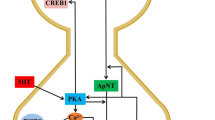Abstract
Working memory represents the ability of the brain to hold information for relatively short periods of time. Working memory is believed mediated by persistent neuronal firing. A broadly accepted hypothesis is that persistent activity is generated by reverberating synaptic input. However, single cortical neurons capable of showing persistent firing were recently reported. In this modeling study, we propose a cellular mechanism to generate persistent firing of multiple firing rates in single neurons. In the proposed mechanism, bistable concentrations of inositol 1,4,5-trisphosphate (IP3) and Ca2+ is achieved by IP3 formation and IP3-induced Ca2+ release from stores in multiple subcellular domains. A postsynaptic firing rate-dependent switching of these bistable elements can demonstrate graded persistent firing of the rat entorhinal neurons. Such a firing rate-dependent switching may be extended to a variety of intracellular Ca2+ signaling cascades.
Similar content being viewed by others
Author information
Authors and Affiliations
Rights and permissions
About this article
Cite this article
Teramae, JN., Fukai, T. A Cellular Mechanism for Graded Persistent Activity in a Model Neuron and Its Implications in Working Memory. J Comput Neurosci 18, 105–121 (2005). https://doi.org/10.1007/s10827-005-5474-6
Received:
Revised:
Accepted:
Issue Date:
DOI: https://doi.org/10.1007/s10827-005-5474-6




